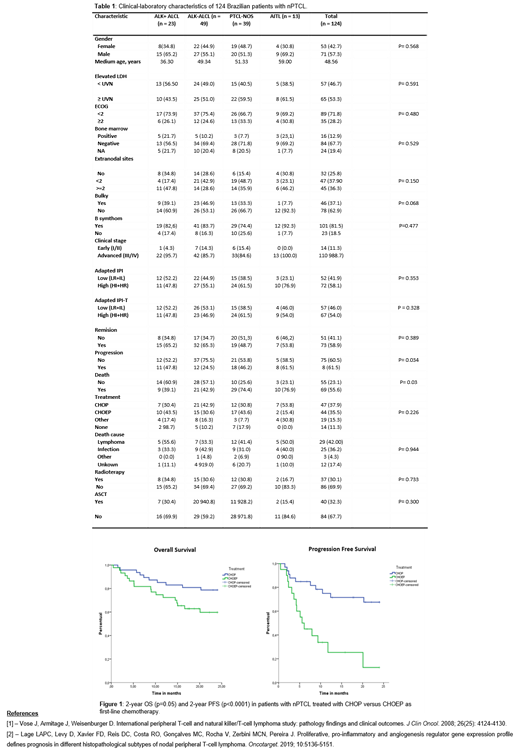Abstract
Introduction: Nodal PTCL constitute a heterogeneous group of rare malignancies derived from CD4+ T-helper, CD8+ T-cytotoxic or follicular T-helper lymphocytes. It presents aggressive clinical-biological behavior and distinct outcomes [1]. These tumors have significant geographic variation, making important studies of clinical and epidemiological characteristics and outcomes of patients in specific areas of the word. Latin American data on nPTCL are scarce in the literature [2] and its first-line treatment is still controversial and ineffective, due to high rates of primary chemo-resistance. Therefore, this study aims to describe clinical, laboratory and epidemiological characteristics, identify prognostic factors and analyze the outcomes of patients with nPTCL treated with CHOP/CHOP-like regimens as first-line therapy in Brazil.
Methods: This is a retrospective, observational and unicentric study involving 124-Brazilian patients with nPTCL treated at HC/FMUSP from January 2000 to December 2017. All cases were submitted to centralized histopathological review and classified according to WHO-2016 criteria on PTCL/NOS, AITL, ALK+/ALCL or ALK-/ALCL. Clinical-laboratory and outcomes data were obtained from digital medical records. Descriptive variables were arranged in absolute numbers and relative frequencies. OS and PFS curves were estimated by the Kaplan-Meier method. Univariate Cox analysis was used to determine factors with prognostic impact through the association between categorical variables and survival curves. Variables that were significant in the univariate analysis were tested in a multivariate analysis to establish independent variables. Statistical analysis was performed using SPSS V.22 software and p-values ≤ 0.05 were considered statistically significant.
Results: The clinical-laboratory characteristics of 124 nPTCL patients were summarized in Table 1. With a median age of 48.5 years (18-87 years) and 57.3% of male, about 81.5% had B-symptoms, 88.7% with CS III/IV and 58.1% had IPI ≥ 3. ORR to first-line treatment was 58.9%, 37.9% (47/124) were treated with CHOP regimen and 35.5% (44/124) with CHOEP, 30.1% (37/124) were submitted to radiotherapy and 32.3% (40/124) were consolidated with ASCT. We observed a higher 2-year OS for patients treated with CHOP versus CHOEP (78.7% vs. 61.4%; p=0.05), as well as a better 2-year PFS for the same regimen (69.7% vs. 25.0%; p<0.0001) - Figure 1. CHOEP treatment was associated with higher rates of G3-4 neutropenia, febrile neutropenia and G3-4 thrombocytopenia (57% x 88% p=0.001, 38% x 70% p=0.003 and 27% x 63% p=0.0007, respectively). Overall mortality was 55.6% (69/124) during all follow-up, with disease progression being the major cause of death (29/69 - 42.0%). With a median follow-up of 23.7 months (0.10-278.6 months), medians of OS and PFS were 48.0 months (95% CI: 9.0-86.9) and 8.8 months (95% CI: 3.9-13.7), respectively. Estimative of 2-year OS and PFS for the global cohort were 61.3% and 41.5%, respectively. In the univariate analysis, factors with a favorable prognostic impact on OS were: IPI < 3 (HR: 0.30; 95% CI: 0.15-0.58; p<0.0001), absence of bone marrow infiltration (HR: 0.39; 95% CI: 0.20-0.75; p=0.005), LDH < 480 U/L (HR: 0.36; 95% CI: 0.19-0.68; p=0.002), radiotherapy (HR: 0.23; 95% CI: 0.10-0.55; p=0.001) and ASCT (HR: 0.28; 95% CI: 0.004-0.30; p<0.0001). Factors associated with better 2-year PFS were: IPI < 3 (HR: 0.36; 95% CI: 0.18-0.71, p=0.004), absence of bone marrow infiltration (HR: 0.30; 95% CI: 0.26-0.55; p=0.03 ), LDH < 480 U/L (HR: 0.36; 95% CI: 0.19-0.67; p=0.001), radiotherapy (HR: 0.17; 95% CI: 0.06-0.44; p<0.0001) and ASCT (HR: 0.03 ; 95% CI: 0.004-0.23); p=0.001). In the multivariate analysis, factors associated with better 2-year OS were: LDH < 480 U/L (HR: 0.40; 95% CI: 0.21-0.76); p=0.005) and ASCT (HR: 0.47; 95% CI: 0.006-0.34; p=0.003). LDH < 480 U/L (HR: 0.45; 95% CI: 0.23-0.87; p=0.01) and ASCT (HR: 0.07; 95% CI: 0.01-0.54; p=0.01) were also associated with higher 2-year PFS.
Conclusion: This is the largest real-life Latin American nPTCL cohort published to date. Patients with nPTCL have poor survival and high rate of chemo-resistance. In our cohort, adding etoposide to the CHOP regimen showed no survival benefit and was associated with high toxicity. Normal values of LDH and consolidation with ASCT were independent factors associated with better outcomes in Brazilian patients with nPTCL.
No relevant conflicts of interest to declare.


This feature is available to Subscribers Only
Sign In or Create an Account Close Modal